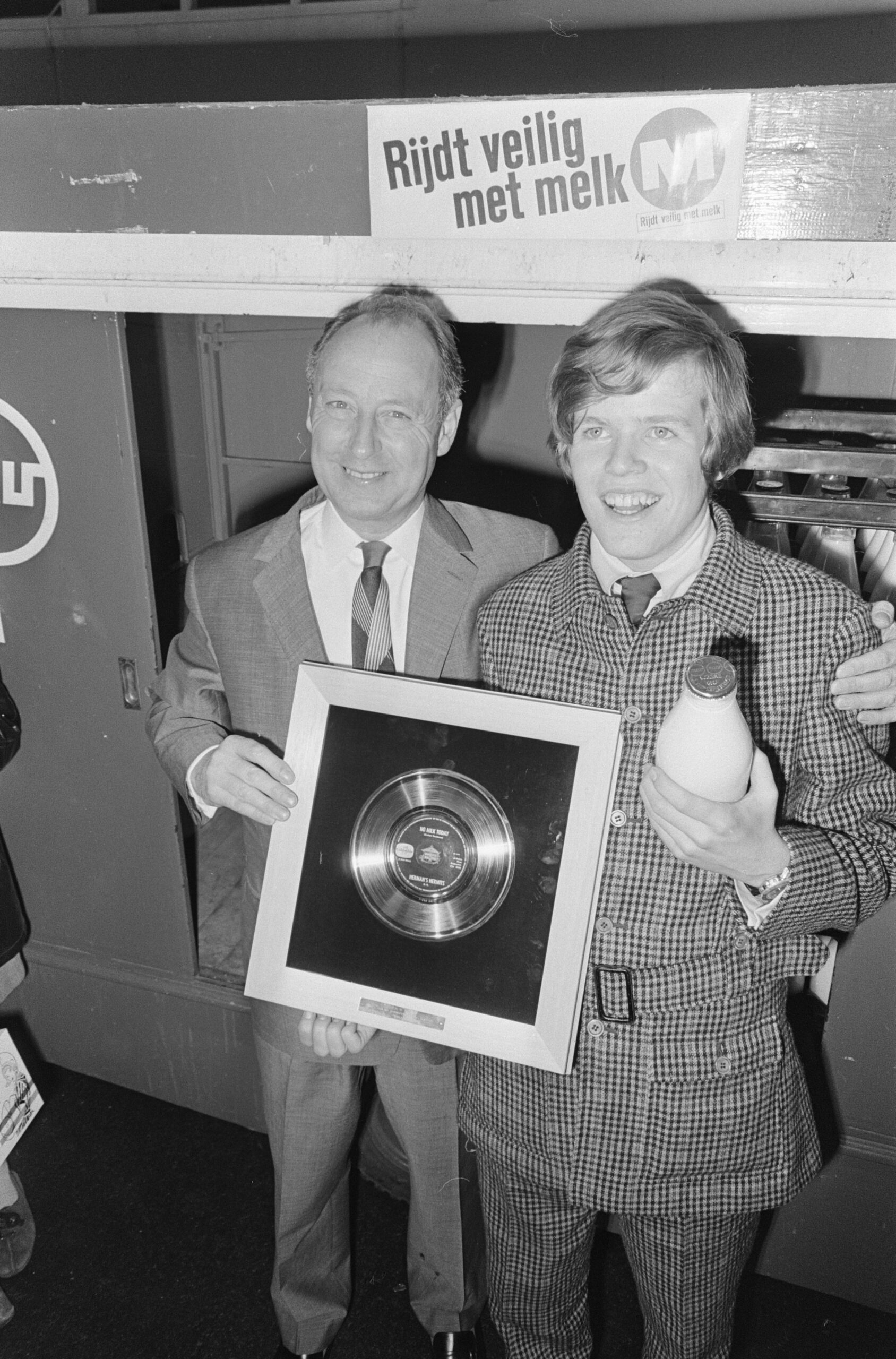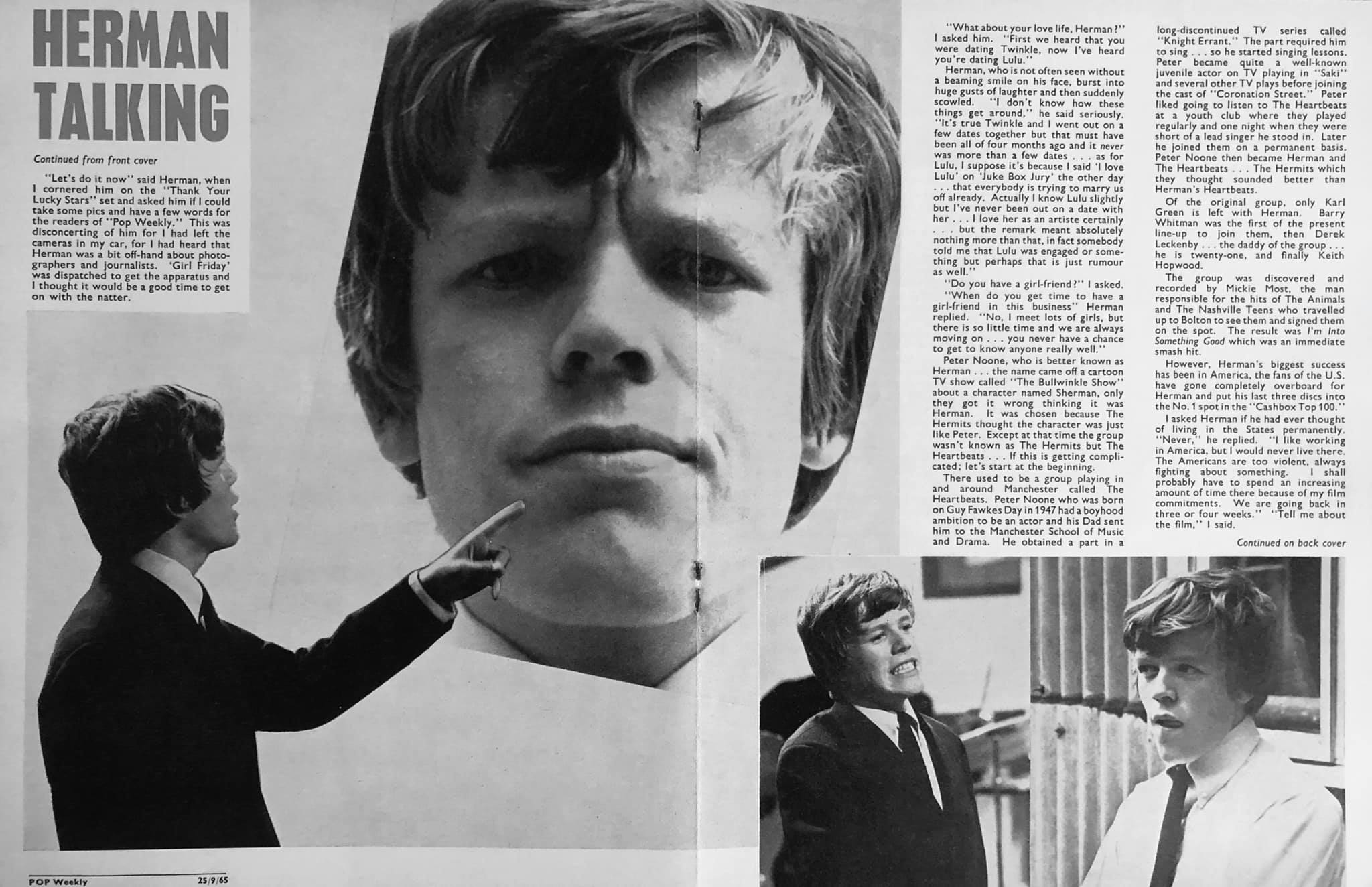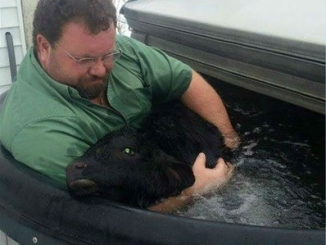Peter Noone was one member of the popular 60’s band, Herman’s Hermits.
With his thick head of hair and boyish charm, it would be easy to compare him to a Justin Beiber or Harry Styles of today.
However, there is one distinct difference between this former teen heartthrob and those of today…

With his adorable face and equally adorable voice, Peter Noone skyrocketed to stardom in his teens as the frontman of Herman’s Hermits. The band toured both in America and Britain and became iconic.
The band nabbed their first number 1 hit in England in 1964 with “I’m Into Something Good.”
“Herman’s Hermits sold millions of records before anyone even saw us, which just doesn’t happen now,” Noone said.
“I didn’t know what I was doing: my stage persona was a shy little boy, which is basically what I was.”

Noone and the rest of his band released more than 20 hit records and even outsold the Beatles in 1965. Some of their biggest hits included I’m Into Something Good, No Milk Today and There’s A Kind of Hush (All Over the World).
The band received a million-dollar record deal by the time they were 17, and one of the highlights of Noone’s career was when Elvis Presley performed one of their hits–”I’m Henry the Eighth, I Am”–in 1965 on stage.
“He was making fun of me, but who cares?” says Noone. “It was Elvis!”
Even at this young age, Noone was living the quintessential rocker lifestyle.
“Although without the drugs bit,” he insists. “That was never my thing.”
But when asked about all of the other typical rock ‘n’ roll habits?

“Sure. We were 16, 17, and we could easily stay up all night, go on the rampage then be up the next morning to do interviews and go to gigs. It was a brilliant time.”
At 64, Noone is on the road again as part of Britain’s Solid Silver 60s Show. His fellow Hermits veterans will not be joining him, but other musical star of the era will–Brian Poole of The Tremeloes (“Do You Love Me” and “Twist And Shout”) and Brian Hyland (“Itsy Bitsy Teenie Weenie Yellow Polka Dot Bikini”).
“You never get tired of the buzz of touring,’ says Noone, ‘and it’s good to know we can still pull an audience. People come up to me and sing all the old songs to my face, although I’m never really sure how to respond to that.”
Noone has lived in California since the 70’s and grew quickly to the healthy living style that characterizes the state.
“Not many people survived the debauchery of the sixties,” he says, “so I feel very lucky and try to look after myself. When I went to Mickie Most’s funeral nine years ago [Most was the band’s producer and a panelist on TV talent show New Faces], there weren’t many people left. It does make you stop and think.”

“I remember going to the house of one of the Moody Blues and it was considered this real den of iniquity,” he says. “None of the girls smoked dope, so I used to hang out with them. I was a fly on the wall.
“I did like to drink — I used to go out with Richard Harris and try to drink more than him,” Noone laughed.
“I used to love the Beatles and the Stones and I’d always want to hang out with them, even though they were about seven years older.
“We’d go to the Ad Lib club in London, and John Lennon would buy my drinks because he knew I was only 16 and I wouldn’t get drunk and try to beat someone up.”
Noone, who grew up in Manchester, has admitted that one of his major motivations for drinking was to fit in with the others, as he didn’t feel that “interesting.”
It was at the age of 19 that the musician decided to attend his first Alcoholics Anonymous meeting with his father, also an avid drinker.
“I wouldn’t have classed myself as an alcoholic, but you have to be sensitive to people’s feelings and be able to do the job on stage, so after that I decided to cut down. I needed to do it for my own sake and haven’t touched a drop for about 16 years.
“I insist that my wife still drinks if she wants to — I wouldn’t stop other people around me doing it.”
The multi-talented entertainer has been married to his wife, Mirielle, for 43 years. They met when Noone was 20, while he was still spending time with various women.
“I think it was probably lust at first sight with Mireille,” he admits. “Then I found out how nice she was and it turned to love.
“She kept turning me down, but she was holidaying on Ibiza with her mum, so I rented the apartment next to them. Her mother liked me because I was respectful. I wore Mireille down.”
The couple married in 1968, had one daughter (Nicole), and Noone quit the band in 1971 at the age of 24.
“Even though all of us in the band were close in the beginning, by the end, we’d been together so long and wanted to do different things.”

His attempted solo career plateaued, and it was in the 80s that he took to a new stage, appearing in a Broadway production on “Pirates of Penzance” and as a host on the U.S. television music show “My Generation”.
Just a few years ago, he appeared as a mentor and voice coach on American Idol.
Speaking on the show, he said, “If the Beatles had entered a TV competition, they’d probably have lost. Simon Cowell seems like a very nice guy, but I think he’s a secondhand Mickie Most to be honest.”
Speaking on the current tour again, Noone explained, “‘I was probably going to be a clerk at the local NatWest. How lucky am I to still be doing this at 64? I know what I’m doing now, too. I’m not that shy little kid any more.”
After Mom’s Death, Son Kicks Stepdad Out of the House & Posh Car Stops in Front of the Old Man — Story of the Day

A man is abandoned by the stepson he raised as his own after his wife died, and is unexpectedly rescued by a kind young man.
Do you believe in karma? Bob didn’t. He lived his life and made his decisions with no thought for anyone except himself. What he wanted was what was right, no matter the cost to everyone else.
Bob never imagined that his attitude would reverberate down the years until he found himself standing by the side of a lonely road watching his only family drive away, leaving him alone, abandoned.

Bob was stunned when his stepson turned him out like a stray dog | Source: Shutterstock.com
The man driving away from Bob was Sam, his stepson, the boy he’d raised as his own and loved with all his heart from the time he was five years old. Back then, Bob had been on the verge of marriage when he’d met Sam’s mother, Adele.
Adele had been beautiful, charming, exciting, and Bob had walked out on his fiancée without an explanation. He left his old life behind like a dirty shirt and married the wealthy Adele.
For thirty years Bob and Adele had been happy. They traveled around the world living a life of luxury in the inheritance she had received on the death of her wealthy old husband — Sam’s father.
Bob thought they had been a happy family until Adele had become very ill. Unfortunately, not all the money in the world could save her from the terrible cancer that burned through her frail body.

Selfish Bob had walked away from his fiancée to marry a rich woman with a child | Source: Pexels
When they lowered Adele’s coffin into the ground, Bob had stood by the graveside, shaking. “My love,” he whispered, “I will never forget you, never! And I promise you I will look after Sam.”
But unfortunately for Bob, Sam had made no such promises. A few days after Adele’s death, her lawyer called Bob and Sam and explained that she hadn’t left a will, and the estate would be in Sam’s hands provisionally.
Be careful of the examples you give the young because they will surely follow them.
“Until we can ascertain Bob’s rights, Sam,” the lawyer explained. “Since the bulk of the estate was left by your father…”
Sam had smiled. “Of course…That seems very fair to me, and Bob, you can be sure I’ll be fair.” Bob smiled and thanked Sam for his kindness, never imagining the true intention behind his words.

Bob raised Adele’s son as if he were his own | Source: Unsplash
That weekend, Sam invited Bob to go for a drive out in the country to get some fresh air. “Bob,” he said. “We need to get rid of the cobwebs before we can start a new life!”
The two had driven off in Sam’s convertible and Bob had noticed that his stepson was uncharacteristically quiet, even though he smiled a lot, and looked amused.
When they were outside the city limits, Sam stopped the car. “Get out,” he said. “Get out now.”
“Sam?” asked Bob, bewildered. “What’s going on?”

When Adele passed away, Bob was devastated | Source: Pexels
“As I told you, I’m getting rid of the cobwebs, starting a new life,” Sam said with a nasty little smile. “And you’re dead weight, old man.”
“But…I promised your mother I’d look out for you…” Bob gasped.
“But I never made her any promises,” his stepson said. “I don’t owe YOU anything. You lived off her for thirty years, that’s long enough, don’t you think?”
“I love you!” whispered Bob with tears in his eyes. “You were like a son to me, I thought you cared for me!”
“Care?” asked Sam. “What I care about is all that money and I’m not about to share it with you. It’s MY money, old man, so get lost!”

His stepson Sam seemed very supportive, but after the funeral, Bob was in for a surprise | Source: Unsplash
Sam made a threatening gesture and Bob stumbled out of the car trembling. He stood and watched as Sam’s car vanished in a dwindling cloud of dust.
He looked around. The emptiness stretched out in all directions from horizon to horizon, and he had nothing except his walking stick. He started wobbling after Sam’s car, thinking that sooner or later he’d come across a house, or be overtaken by another vehicle.
Surely someone would be kind enough to stop for an old man? But car after car sped by, and no one stopped. After a while, Bob stopped trying to flag them down. He just stopped where he was.
The sun was going down and it was getting very cold when a large expensive-looking car stopped next to him. “Sir,” asked a kindly voice. “Are you alright?”

The lawyer told Sam and Bob that Adele had died without a will | Source: Unsplash
Bob felt tears fill his eyes at the sound of the concern in that stranger’s voice. “No,” he said shakily. “I’ve been abandoned here. Please, if you could take me to the nearest town, a police station? If it’s not too much trouble!”
“Abandoned?” the man sounded shocked. “That’s shocking! Please get in.”
The driver was a young man in his early thirties with a friendly smile and kindly blue eyes. He reminded Bob of someone, but he couldn’t remember who it was. Bob told the man, whose name was Jake Kale his whole story.
Jake was indignant, and when he saw that Bob was shaking from the cold, he decided to take him home. “I’ll take you to the police tomorrow morning, Bob,” he said. “Tonight you get warm and have a good meal and a restful sleep.”

Sam invited Bob to go for a drive | Source: Unsplash
Jake led Bob into a lovely cozy home and introduced him to his wife Angela and his daughter Faye. “My mother is joining us for dinner, Bob,” Jake said. As he was speaking, a cheerful voice called out a greeting and a sweet-faced woman in her sixties walked in.
She had Jake’s eyes, Bob noticed, and once again he had the eery feeling that he knew her from somewhere, but where? Bob was stunned when the woman turned and saw him standing there. She cried out, and Jake had to grab her before she fell.
“Mom!” Jake cried, “Are you OK?”
“That man…” gasped Peggy Kale. “Bob…It’s you!”

“It’s MY money, old man, so get lost!” | Source: Unsplash
“I’m Bob,” said Bob bewildered, “But how did you know?” Then he saw the years fall away from that sweet face. “Peggy! After all these years!”
“How did you get here? How did you find us?” Peggy asked.
Bob shook his head. “It was Jake who found me, rescued me. I was abandoned on the road. He picked me up. He’s your son?”
“Yes,” Peggy said quietly. “My son…and yours.”

A kind man driving by stopped and took Bob home | Source: Unsplash
“Mine?” whispered Bob. “You were pregnant? You didn’t tell me!”
“You walked away a week before our wedding,” Peggy said. “I didn’t know then — and later it didn’t seem to matter. You didn’t want me, and I wasn’t going to use my baby to pressure you.”
Bob lowered his head and cried bitter tears. “I raised Adele’s son!” he whispered. “You knew that?”
And as Peggy nodded, Bob continued bitterly: “It was Adele’s boy — whom I thought was my boy, who abandoned me by the side of the road like a stray dog.”

Jake’s mother was the fiancée Bob had abandoned | Source: Pexels
Peggy smiled. “And it was my son who saved you…Think about that, Bob!”
Bob did. He spent the night tossing and turning, thinking about the choices he’d made, the examples he’d given Sam. He’d raised a selfish, grasping, dishonest man, and Peggy had raised a good, generous one.
The next day, Jake took Bob to a police station and lodged a complaint against Sam. Jake got Bob a good lawyer and the courts awarded Bob half of Adele’s substantial estate.
Shortly after the court’s decision, Bob signed over every cent to his son Jake, and to his granddaughter. He begged Peggy’s forgiveness and he is now working hard at making it up to his son and his ex-fiancée.

Bob found the family he didn’t know he had | Source: Unsplash
What can we learn from this story?
- Be careful of the examples you give the young because they will surely follow them. Bob was a selfish man, and that was the example he gave his stepson.
- Fate will bring you face to face with your greatest mistakes so you can make amends. The man who rescued Bob was his biological son whom he had apparently abandoned before he was born.
Share this story with your friends. It might brighten their day and inspire them.
If you enjoyed this story, you might like this one about a woman who is shocked when she sees a homeless stranger wearing the pendant she’d buried with her fiancé after his death in a car crash.
This account is inspired by our reader’s story and written by a professional writer. Any resemblance to actual names or locations is purely coincidental. All images are for illustration purposes only. Share your story with us; maybe it will change someone’s life.



Leave a Reply